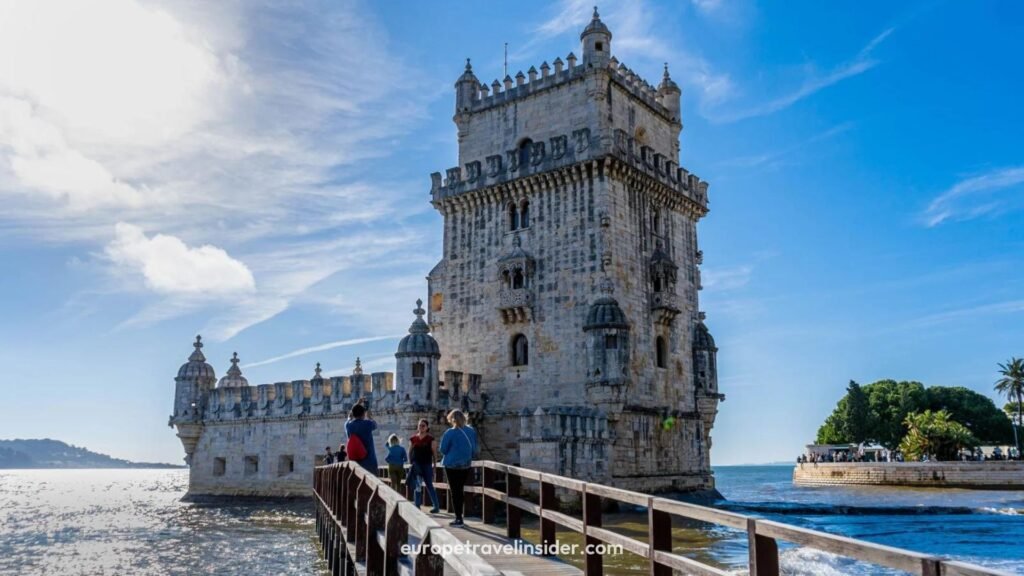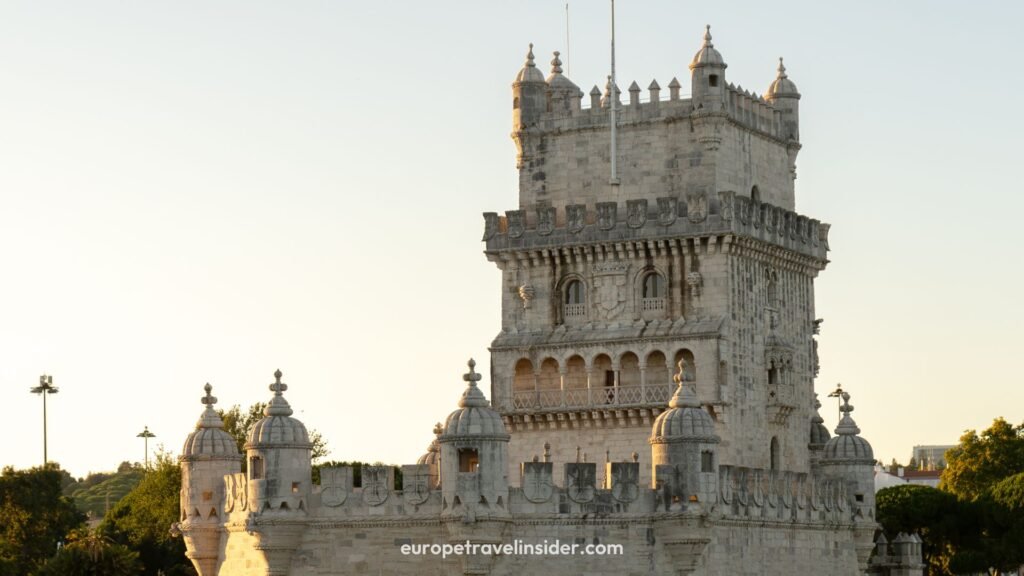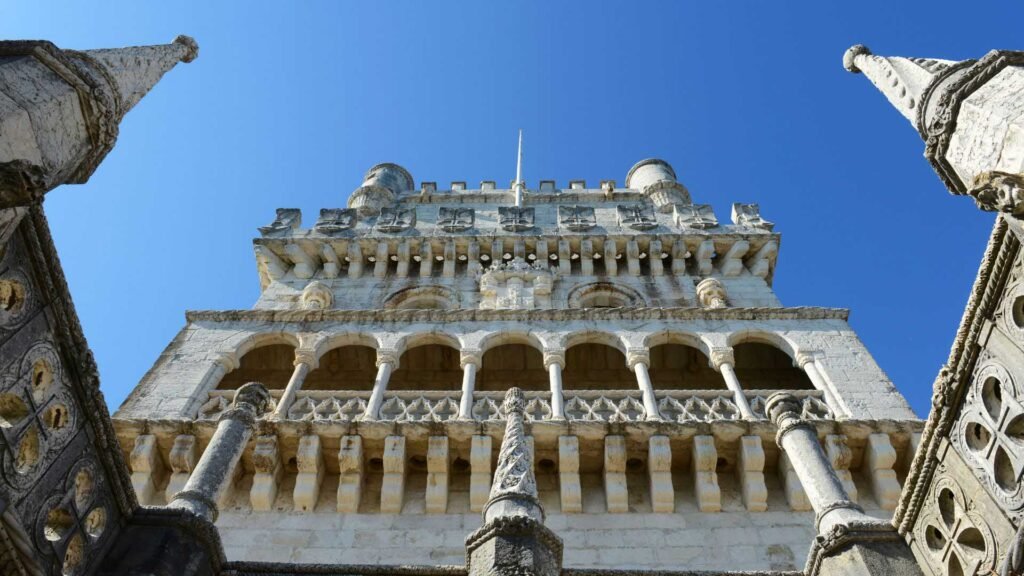Let the river lead you west in Lisbon, and you’ll eventually encounter the imposing 16th-century Belém Tower. For locals, this place is more than a stone structure — it’s a symbol of their maritime history and connection with the brave sailors who set out from these shores.
No visit to Lisbon is complete without visiting Belém, and while you’re here, it’s worth stopping at the tower to witness the unique medical style and learn about the history of local navigators during the Age of Discovery.
History of the Belém Tower

The history of the Belém Tower spans more than five centuries.
Built in 1515 during the Age of Discovery (which was between 1514 and 1520) and designed by architect Francisco de Arruda, the tower was initially conceived as part of Lisbon’s defensive system but also served as a lighthouse and gateway to the city. Its purpose was to serve as a defensive fortification, protecting the city and its maritime trade routes.
Its Manueline, Gothic, and Moorish styles are all remnants of the Portuguese Renaissance, identifiable by ornamental details that evoke nautical motifs, such as ropes, sculptures of armillary spheres, and crosses of the Order of Christ.
Perhaps most interestingly for those who love history (like us!) is that the Belém Tower has witnessed countless historical events, from its role in defense against invasions to its use as a prison during the 17th century. Its cells once even housed (or jailed, rather) the famous poet Luis Camões.
The Belém Tower was originally built on a small rocky island, but over the centuries and due to changes in the coastline, it’s now connected to the mainland. The tower has also survived earthquakes and has been restored several times to preserve its original style.
What About the Design of the Belém Tower?

The Belém Tower is an architectural example of 16th-century military design. Built between 1514 and 1520, the stone structure, which mixes Gothic, Manueline, and Moorish styles, served as a fortress to protect the city from maritime raids.
This five-level tower stands on a square platform at its base and an octagonal structure at its upper levels, reaching a height of 35 meters. Its intricate ornamentation, with twisted ropes and nautical motifs, reflects the influence of the Portuguese Age of Discovery.
Inside, the arched windows, sculptural reliefs, and heraldic motifs add an artistic touch to its military design. You’ll also find unique tile panels that decorate it and tell the history of Portuguese navigation and exploration.
The presence of the “Cross of Christ” throughout much of the tower symbolizes the connection with the maritime exploration and expansion of religion in Portugal at that time.
The Belém Tower was declared a World Heritage Site by UNESCO in 1983. While that’s not likely such a “fun” fact, this one might be — on the facade, you’ll find a rhinoceros, which symbolizes the exotic fauna found during the Age of Discoveries.
The Belem Tower as a Defensive Tower

The need for a defensive tower arose due to the importance of Lisbon as a seaport during the Age of Discovery. Throughout this period, numerous naval expeditions were carried out to explore new territories and trade routes, turning Lisbon into an important international business center.
The Belém Tower witnessed several historical events, including various sieges. During the Restoration of Portuguese Independence in 1640, it withstood Spanish invasion attempts. Additionally, during the War of the Spanish Succession (1701-1714), it also played a crucial defensive role.
Another notable moment was during the Napoleonic Invasion of Portugal at the beginning of the 19th century. Although the monument didn’t suffer significant damage, it was occupied by French troops for a period. After their removal, the tower regained its defensive function and became a symbol of resistance.
The Belém Tower was built with an advanced defensive style, characterized by its battlements, sentry boxes and a design that allowed the effective use of firearms — namely cannons.
A Look Inside the Belem Tower

The Belém Tower might look impressive on the outside, but is it really worth visiting inside? It depends on what you’re interested in, honestly, and how much time you have.
The interior is divided into five floors: the first three acted as housing (the Governor’s Room, the Kings’ Room, and the Audience Room). The fourth floor has a chapel, and on the fifth floor, you’ll find a magnificent terrace with great river views.
Its interior, although austere, isn’t boring, either. It’s true that the best views of the tower itself are seen from the outside. However, if you’re interested in seeing a few of the tower’s details up close and would like to snap some unique photos of the Tagus River, it’s worth it to pay to go inside.
If you do, schedule your visit in the morning to avoid crowds. After the tour, head over to the Pastés de Belem nearby to sample a Pastéis de Nata and end your day on a sweet treat (they really are worth the hype — do yourself a favor and buy a whole sleeve).
Some sculptures of Saint Vincent (the patron saint of Lisbon) adorn the Belém Tower, paying homage to the Holy Martyr.
Visiting the Belém Tower

You have two main choices when visiting the Belém Tower: Purchase tickets yourself or take a guided tour.
If you have the budget for it, we always suggest taking a guided tour, as they support the local economy and are led by local experts, which will allow you to learn more about the secrets and stories of this emblematic monument.
Depending on the tour you choose, it might also include exclusive access to restricted areas. However, you can also explore the place by yourself to enjoy the flexibility of taking your time to enjoy the place at your own pace.
Tickets alone cost €8 for adults if you don’t purchase them as part of a tour, but you’ll want to book at least a couple of days in advance to ensure you get a spot.
How to Get to the Torre de Belém
Getting to the Belém Tower from the center of Lisbon is quite simple and cheap. However, it’s a bit further out than most people realize, meaning you can’t really walk there from Lisbon (although we did take electric scooters once, which was…an adventure).
We think taking the train from Cais do Sodré to Belém is the easiest and cheapest option, but here are some of the quickest and easiest transportation options.
| Public Transport | Bus | Tram | Train |
| Description | There are various bus lines that connect travelers from the center of Lisbon to Belém — namely the 714 and 728. If you choose this route, head to the Praça do Comércio and catch the bus just in front of the Cais do Sodré train station. A one-way ticket costs €1.80. | While you won’t be able to take one of the classic trams to Belém, the 15E electric tram also stops outside of the Cais do Sodré train station. A one-way ticket costs €3. | This is our preferred way to get to Belém! It’s fast, cheap, and simple. Head to the Cais do Sodré train station and either purchase your ticket at the window or from one of the machines. It should only cost about €1-2! |
| Frequency | Generally, every 10-15 minutes | Every 10-15 minutes (these usually arrive and depart on time more frequently than the buses it seems) | Every 15-20 minutes |
| Travel Time | About 25-30 minutes | About 35 minutes (although it feels soooo much longer!) | About 7-10 minutes |
Other Ways to Get to Belém Tower
| Walking | We can’t deny that the walk to Belém from Lisbon’s main square is scenic, especially on a sunny day! It’s also quite a simple route without many hills. However, the Belém Tower is located about 5 -6 km southwest of the center of Lisbon, meaning it will take you between 1.5-2 hours to get there, depending on your pace and weather conditions. |
| Bicycle | Lisbon has a public bicycle rental system called GIRA. You can use the official GIRA Map to see all the stations and their availability or use the GIRA Mobile Application to obtain real-time information. You’ll have to bike that 5 – 6 km to the tower, but it should only take you about 20-30 minutes. |
| Taxi, Uber or Bolt | Taking a Taxi, Uber, or Bolt is a comfortable, convenient, and fast option to get to the Belém Tower. Depending on where you’re coming from in Lisbon, the ride should only take about 15 to 20 minutes, depending on traffic conditions. We prefer Bolt, as they offer the cheapest prices and have the best coverage in Lisbon. |
| Ship | If you’re staying on the southern side of the Tagus River, you can use the ferry service that’ll take you straight to the Estação Fluvial de Belem. As for the travel time, it will depend on the type of service you use, although the ferries are usually quite fast. |
Again, we’ve tried various methods to get to the Belém Tower from central Lisbon, and we prefer the train. However, you can choose the one that best suits your preferences, budget, and schedule.
Belém Tower Opening Hours
Ready to plan your visit? Ensure you plan to visit during the correct hours!
OPENING HOURS 2024
| All year | 9:30 a.m. to 6:00 p.m. | Tuesday to Sunday | Closed every Monday | Last entry 30 minutes before closing time |
| Closed | January 1 | Easter Sunday | May 1 | June 13 | December 25 |
For a quiet experience without crowds, we recommend visiting the Torre de Belém during the morning or early afternoon. This way, you can make the most of your tour.
Torre de Belém Ticket Price
How much will visiting this Lisbon landmark cost you? Here are the updated prices for 2024. You can purchase a ticket only for entry to the tower, but we suggest combining it with a ticket to the nearby Jerónimos Monastery, as that is also definitely worth entering if you have time!
TORRE DE BELÉM PRICES
| Adults | €8 |
| Over 65 years old | Discounted |
| Families (Parents + 2 children) | Discounted |
| Youth Card | Discounted |
| Children 0-12 years old | FREE |
| Lisbon Card | INCLUDED |
Remember that the money you pay to enter the Belém Tower goes towards the maintenance and care of this emblematic Portuguese monument.




